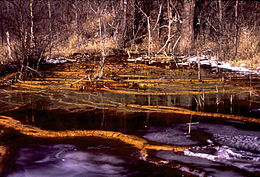
Ferrihydrite

Ferrihydrite (Fh) is a widespread hydrous ferric oxyhydroxide mineral at the Earth's surface, and a likely constituent in extraterrestrial materials. It forms in several types of environments, from freshwater to marine systems, aquifers to hydrothermal hot springs and scales, soils, and areas affected by mining. It can be precipitated directly from oxygenated iron-rich aqueous solutions, or by bacteria either as a result of a metabolic activity or passive sorption of dissolved iron followed by nucleation reactions. Ferrihydrite also occurs in the core of the ferritin protein from many living organisms, for the purpose of intra-cellular iron storage.Ferrihydrite precipitate from coal mine water.Spring in the Zillertaler Alps with Fh precipitate.Seepage of iron-rich water.Transformation of ferrihydrite (top) to goethite (bottom).Water treatment plant using the slow sand filter technology to treat raw water.Tricolor (RGB) X-ray fluorescence image of the distribution of As (red), Fe (green), and Mn (blue) in coated quartz grains from a water treatment sand bed. Ferrihydrite (Fh) is a widespread hydrous ferric oxyhydroxide mineral at the Earth's surface, and a likely constituent in extraterrestrial materials. It forms in several types of environments, from freshwater to marine systems, aquifers to hydrothermal hot springs and scales, soils, and areas affected by mining. It can be precipitated directly from oxygenated iron-rich aqueous solutions, or by bacteria either as a result of a metabolic activity or passive sorption of dissolved iron followed by nucleation reactions. Ferrihydrite also occurs in the core of the ferritin protein from many living organisms, for the purpose of intra-cellular iron storage. Ferrihydrite only exists as a fine grained and highly defective nanomaterial. The powder X-ray diffraction pattern of Fh contains two scattering bands in its most disordered state, and a maximum of six strong lines in its most crystalline state. The principal difference between these two diffraction end-members, commonly named two-line and six-line ferrihydrites, is the size of the constitutive crystallites. The six-line form has been classified as a mineral by the IMA in 1973 with the nominal chemical formula 5Fe2O3•9H2O. Other proposed formulas were Fe5HO8•4H2O and Fe2O3•2FeO(OH)•2.6H2O. However, its formula is fundamentally indeterminate as its water content is variable. The two-line form is also called hydrous ferric oxides (HFO). Due to the nanoparticulate nature of ferrihydrite, the structure has remained elusive for many years and is still a matter of controversy. Drits et al., using X-ray diffraction data, proposed a multiphase material with three components: defect-free crystallites (f-phase) with double-hexagonal stacking of oxygen and hydroxyl layers (ABAC sequence) and disordered octahedral Fe occupancies, defective crystallites (d-phase) with a short-range feroxyhite-like (δ-FeOOH) structure, and subordinate ultradisperse hematite (α-Fe2O3). Recently, a new single phase model for both ferrihydrite and hydromaghemite has been proposed by Michel et al., based on pair distribution function (PDF) analysis of x-ray total scattering data. The structural model, isostructural with the mineral akdalaite (Al10O14(OH)2), contains 20% tetrahedrally and 80% octahedrally coordinated iron. Because of the small size of individual nanocrystals, Fh is nanoporous yielding large surface areas of several hundred square meters per gram. In addition to having a high surface area to volume ratio, Fh also has a high density of local or point defects, such as dangling bonds and vacancies. These properties confer a high ability to adsorb many environmentally important chemical species, including arsenic, lead, phosphate, and organic molecules (e.g., humic and fulvic acids). Its strong and extensive interaction with trace metals and metalloids is used in industry, at large-scale in water purification plants, as in North Germany and to produce the city water at Hiroshima, and at small scale to clean wastewaters and groundwaters, for example to remove arsenic from industrial effluents and drinking water. Its nanoporosity and high affinity for gold can be used to elaborate Fh-supported nanosized Au particles for the catalytic oxidation of CO at temperatures below 0 °C. Ferrihydrite is a metastable mineral. It is known to be a precursor of more crystalline minerals like hematite and goethite by aggregation-based crystal growth. However, its transformation in natural systems generally is blocked by chemical impurities adsorbed at its surface, for example silica as most of natural ferrihydrites are siliceous. Under reducing conditions as those found in gley soils, or in deep environments depleted in oxygen, and often with the assistance of microbial activity, ferrihydrite can be transformed in green rust, a layered double hydroxide (LDH), also known as the mineral fougerite. However, a short exposure of green rust to atmospheric oxygen is sufficient to oxidize it back to ferrihydrite, making it a very elusive compound.
